|
|
Domino

|
|
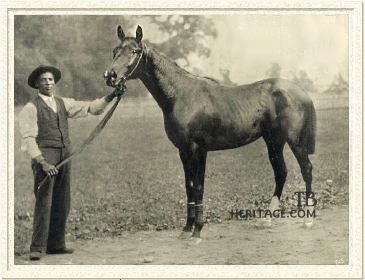 |
|
|
Domino was a horse of extremes, both during his short life, and after
his death. He was the most famous horse that leading owner James R.
Keene was ever associated with, yet, Keene was not enthused about
acquiring the colt as a yearling. Domino was brilliantly fast, virtually
unbeatable at a mile or less, but his record was less than stellar at
longer distances. But as a stallion, he sired three major stakes
winners--Commando, Cap and Bells, and Disguise-- that ran their best
races at 1-1/4 miles and beyond. Domino sired only 19 named foals, yet
almost every Thoroughbred today carries Domino in their family tree.
His breeder was Major Barak Thomas, master of Dixiana Stud near
Lexington, Kentucky. Thomas had trained Hegira, bred and owned by
Thomas's brother, Charles. The Thomas brothers were split in their
loyalties during the Civil War, with Charles remaining loyal to the
Union and Barak joining the Confederate Army. That proved the financial
undoing for Barak. His fortunes were salvaged when he became the owner
of a filly by Lexington out of Hegira. Named Hira, her stakes winnings
strengthened Thomas' anemic finances.
Hira became an important member of the Dixiana broodmare band. Her
fourth foal, Himyar, by the speedy Alarm, was a major winner on the
Kentucky circuit. One of his best performances was a second place finish
to Day Star in the 1878 Kentucky Derby. Himyar was tough and versatile,
winning half of his 28 starts at distances up to two miles. He could
race successfully in heat races, and he could win on dry or wet tracks.
Himyar had everything to recommend him as a stallion prospect--a good
pedigree, a fine race record, speed and the ability to carry it a
distance. But when he was sent to stud at Dixiana, he was overshadowed
by the stallions already in residence, Fellowcraft and King Ban, and did
not serve the best mares until 1890, at age fifteen, after King Ban had died and Fellowcraft had been sold. When put to more and better mares, he rapidly ascended the sire lists, and with son Domino's assistance became, in 1893, the first U.S. sire to surpass the $200,000 mark in progeny earnings, a record that stood until his grandson, Commando, surpassed it fourteen years later.
The little black mare, Mannie Gray, had joined Thomas' broodmare band at Dixiana in 1880, and was bred to King Ban or Fellowcraft every year between 1881 and 1887, when she was put to Himyar, producing the speedy filly Correction . By Enquirer and
out of Lizzie G., by War Dance, she was inbred, carrying multiple
crosses of Lexington, Boston, Reel, and Glencoe. She was a winner of
only one race at three before being sold to Major Thomas. She had
produced four stakes winners by the time she foaled Domino, on May 4,
1891, including the colt's full sister, Correction (1888), who was
racking up victories in New York while her brother romped in the fields
of Dixiana with his dam.
Domino was a striking colt. He had a dark brown coat, nearly black, with
two white hind socks, a small star and snip of white on his nose. Maj.
Thomas offered him, along with the rest of his 1891 crop as yearlings, at
Tattersalls in New York in June, 1892. At the sale was the famous Wall
Street financier James R. Keene and his son, Foxhall. Keene had enjoyed
success in racing, with the likes of Belmont Stakes winner Spendthrift
and Grand Prix de Paris winner Foxhall. He was seemingly unimpressed
with the Himyar-Mannie Gray colt, and was certain that the colt would go
for a hefty price given that Correction was such a brilliant runner. His
son, Foxhall, on the other hand, was smitten with the sleek colt, and
was not so easily dissuaded. He purchased him for $3,000 (the rest of the
Dixiana crop averaged $875).
Domino on the Turf
The colt was broken as a yearling by Albert Cooper. In his early
breezes, Domino demonstrated the blinding speed that was to become his
hallmark. Cooper nearly ruined him after two rigorous trials in the
space of two days, and the result was that Domino bowed both front
tendons, consequently plagued with soreness throughout his racing life.
Cooper was dismissed as the colt's trainer and veteran horseman William
Lakeland was hired to train Domino, racing the colt in front
bandages to support his sore legs. When Lakeland took over the training,
Foxhall Keene and his father merged their stables, and it was agreed
Domino would race in James Keene's name, though father and son remained
partners.
Domino blazed to easy victories in his first six races. His first start
took place at Sheepshead Bay on May 22, 1893, where Domino won by six
lengths in a field of 13. Domino was partnered for the first time by
jockey Fred Taral, who rode the colt his entire career. Following that
maiden win came victories in the Great American, Great Eclipse, Great
Trial, Hyde Park, and Produce Stakes. Then came the rich Futurity
Stakes, with a purse of over $45,000. Because of the purse, astronomical
for those days, a field of 20 faced the starter, including a tough
chestnut colt, Dobbins, owned by Richard Croker. This marked the first
race in which Domino was ever tested, and it marked the beginning of
Domino's hatred for his rider, Fred Taral.
Because of his unbeaten skein, Domino was assigned 130 pounds. During
the running of the race, his stablemate, Hyder Abad, fell, and Domino
almost went down trying to avoid him. He stayed on his feet and resumed
his run, but was mercilessly punished by Taral with the whip. At the
end, Domino was the victor by a head over Galilee, with Dobbins another
head away in third. Domino was exhausted after this grueling race, but
Keene could not resist the idea of a special match race proposed by
Croker between his colt and Dobbins. The purse was for $10,000, to take
place only two days after the Futurity.
The match race was a thriller, and both colts were stretched to their
utmost. A newspaper account was dramatic in its description of the
race--
"Once, twice, thrice, the lash descended on Domino's quivering flanks,
but still Dobbins crept nearer and nearer...A furlong from home Dobbins'
muzzle showed ahead. Taral shifted his whip from his right to his left
hand and played a tattoo on Domino's ribs that could be heard half a
mile away. His heels were busy, and Domino's sides ran blood...The game
colt that had never known defeat, struggled on, and 100 yards from the
finish there was not a man alive capable of predicting the winner."
|
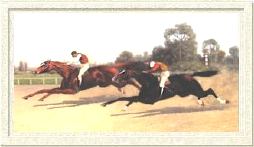
The Great $10,000 Match Race | | 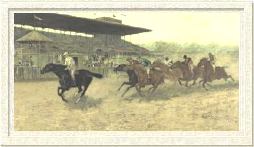
Domino coming in, the Matron Stakes |
The judges were not able to separate the two colts at the wire, and the
race was declared a dead heat. Domino was so exhausted from the race
that he did not come out again until a month later, when, with no
Dobbins in the field, he easily won the Matron Stakes, running the six
furlongs in 1:09, a new record. The victory put Domino's earnings for
the season at $170,790, a juvenile earnings record which stood until
1931, when the filly Top Flight topped it with $219,000.
Following those two races, Domino was not the same. The colt began to
work himself into a frenzy at the sight or sound of his rider. He would
try to savage the jockey, and finally, it became necessary to put a
blanket over his head for Taral to mount. He was also sore, having a
tender foot as well as the delicate front tendons.
Domino was not as dominant at three, but remained unbeatable at sprint
distances. He won five of eight starts at three--the Withers Stakes,
the Culver Stakes, the Flying Stakes, and the Ocean Handicap. He also
won a match race with the previous year's three-year-old champion colt,
Clifford, and in yet another match race, against Henry of Navarre,
winner that year of the Belmont Stakes and the Travers, Domino ran
courageously to force a dead heat.
Domino's biggest loss was in the American Derby, run at 1-1/2 miles, a
distance well beyond his capabilities. Keene and Lakeland thought he
might stay if he were rated, but Domino fought his rider bitterly and
finished ninth and last in the worst performance of his career. Domino's
last race at three was a special match against both Clifford and Henry
of Navarre. Domino re-injured his foot and finished last as Clifford
beat Henry of Navarre.
At four, Domino won four of eight, his stakes wins coming in the Coney
Island and Sheepshead Bay Handicaps. He lost twice to Henry of Navarre,
and also failed to get 1-1/4 miles in the Suburban Handicap, finishing a
well beaten fourth. Again, Keene and Lakeland instructed Taral to try
and rate him, and again, Domino only fought against the restraint.
All told, Domino won 19 of 25 races; he was second twice and third once. His earnings totaled $193,650--a record that stood until Man o' War broke it in 1920. |
|
Domino's Race Record
|
| Year |
Age |
Starts |
1st |
2nd |
3rd |
Unplaced |
Earnings |
| 1893 |
2 |
9 |
9 |
0 |
0 |
0 |
$170,890 |
| 1894 |
3 |
8 |
6 |
0 |
1 |
1 |
19,150 |
| 1895 |
4 |
8 |
4 |
2 |
0 |
2 |
3,610 |
| Total |
-- |
25 |
19 |
2 |
1 |
3 |
$193,650 |
| | Domino may not have been effective at distances of
1-1/8 miles or more, but he dazzled racing fans with his raw speed and
dominance when kept to sprinting, earning the nickname "The Black
Whirlwind." And no one ever questioned his courage, in victory or defeat.
|
Domino in the Stud
Domino was sent to stud at Keene's Castleton Farm near Lexington. On
the train journey, he fell ill and had to be treated in Cincinnati,
where he recovered, then went on to his new home to begin life as a
stallion. Keene was enthused about a breeding theory based on mating
stout British mares to American speed and with the aim, had purchased
several mares in his native England. He had bred the stout campaigner
Kingston, a winner of 89 races, along those lines. Consequently, at
Castleton, there was a large harem of regally bred English mares waiting
to go to the court of Domino.
Domino served only two seasons before he died. His two years at stud
yielded only twenty foals, yet the resulting quality was extraordinary.
From his first crop, Domino was the sire of:
DISGUISE: a brown colt out of Bonnie Gal, by Galopin. Disguise raced in
England, and proved he was very high class. He ran third to Diamond
Jubilee in the Derby Stakes, beat that colt in the Jockey Club Stakes,
and at four, ran third to Epsom Lad in the Eclipse Stakes. As a
stallion, standing first at Castleton and later in California, Disguise
was quite a success. His best offspring was the filly Maskette, winner
at two of the Spinaway, Futurity, and Matron Stakes, and at three, the
Gazelle, Alabama, and Ladies Handicap. Disguise also sired such good
ones as Iron Mask, winner of the Grand Union Hotel Stakes; Helmet,
winner of the Hopeful, Matron, and Champagne Stakes; and Court Dress,
winner of the Fashion and Spinaway Stakes. The offspring of Disguise
excelled as juveniles, but his daughters produced several good horses
capable of getting a distance, including John P. Grier; Pillory, winner
of the Preakness and Belmont; and Questionnaire, a top handicap
campaigner.
DOUBLET, a chestnut colt (later gelded) out of Lucy Wallace, by War
Dance or Ballinkeel. He was a stakes winner who ran for many years.
|
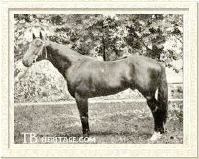
Disguise won the Jockey Club Stakes in England
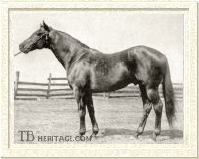
Stakes Winner and Leading Sire Sweep, out of Pink Domino and by Ben Brush
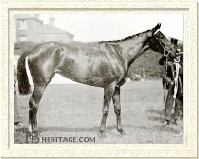
Cap and Bells won the Epsom Oaks
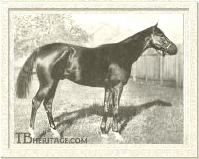
Commando, good race horse and great sire
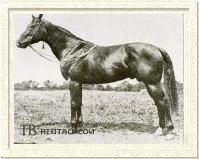
The In-bred Ultimus, by Commando and out of Domino daughter Running Stream
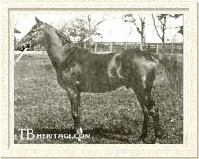
Stakes Winner and Sire Celt, by Domino's son Commando
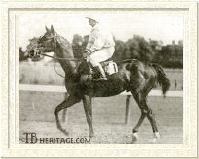
The Unbeaten Champion Colin, by Commando
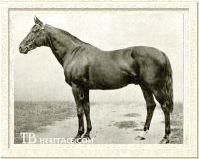
Stakes Winner and Sire Peter Pan, by Commando
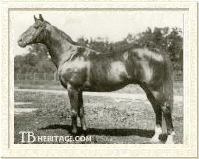
Theodore Cook, out of Domino Daughter Climax and by Ben Brush | |
PINK DOMINO, a bay filly out of Belle Rose, by Beaudesert. A winner, she was an influential broodmare. Her most notable offspring was the Ben
Brush colt Sweep, winner of the Futurity at two and the Belmont at
three. Sweep was a multiple leading sire, with major winners The Porter
and champion filly Untidy to his credit. His daughters produced Kentucky
Derby winner Bubbling Over and two American Triple Crown champions--War
Admiral and Whirlaway. In an interesting instance of inbreeding, Pink
Domino's daughter, Curiosity, produced, to the cover of Disguise, the
filly Wonder, dam of the aforementioned John P. Grier, a gritty little
horse who gave Man o' War a run in the 1920 Dwyer Stakes.
RUNAWAY GIRL, a chestnut filly out of Fair Vision, by Touchet. A minor
stakes winner at two, she became the second dam of Upset, the colt who
handed Man o' War his only defeat in the 1919 Sanford Stakes at
Saratoga.
UNMASKED, a brown colt (later gelded) out of Mere Hill, by Macgregor.
He was a durable sprinter.
BAY COLT out of Ella T., by War Dance. This colt died young, probably as
a yearling.
Domino sired 14 named foals in his second and last crop, they being:
CAP AND BELLS, a brown filly out of Ben-My-Chree, by Galopin. She was a
stakes winner in the United States at two, and then became the first
American-bred filly to capture the Epsom Oaks at three.
CLIMAX, a brown filly out of Orchis, by Bend Or, second dam Lizzie
Agnes. This beautifully bred filly was unraced, but she produced several
winners. Her best was the Ben Brush colt Theo. Cook, who went on to
become a major sire.
COMMANDO, a bay colt out of Emma C., by Darebin. Defeated only once as a
juvenile and a classic winner of the Belmont Stakes at three, Commando
was the most important of Domino's three sons that served at stud. His
offspring included the unbeaten champion Colin, Belmont Stakes winner
Peter Pan, and major stakes winners Celt, Transvaal, Peter Quince, and
Superman. Commando's unraced son Ultimus was a major sire, with such
animals as High Time, Stimulus, and Supremus to his credit. As a
stallion, Celt enjoyed his greatest fame as the broodmare sire of Triple
Crown champion Gallant Fox. Colin, though a shy breeder, became the next
link in the thread to the survival of Domino's male line. Despite siring
only 83 foals in his 23 years at stud, he came up with a son, Neddie,
who kept the sire line going. In 1971, the North American Horse of the
Year, Ack Ack, was a direct male line descendant of Colin's son Neddie,
and Ack Ack kept things going with his son, Broad Brush, North America's
leading sire in 1994 and sire of a number of promising sons that will
hopefully keep Domino's male line from becoming extinct.
COSTUME, a bay filly out of Miss Tilly, by The Miser. She produced
several winners.
DOMINOES, a chestnut filly out of Editha, by Master Kildare. She was
unraced. Her best offspring was the brilliant juvenile colt Dominant, by
Delhi, winner of the Hopeful, Saratoga Special, and the Grand Union
Hotel Stakes. At stud, Dominant sired another crack juvenile colt in
Dice.
DOUBLE SIX, a bay filly out of Gloaming, by Sir Modred. She was a minor
winner and a minor producer, as she only produced two living foals.
GINGHAM, a chestnut filly out of Calico, by Hampton. She produced
several winners, including three English stakes winners.
KIMBERLEY, a chestnut colt (later gelded) out of Elsie, by See-Saw.
Kimberley was a good winner for a number of years.
MARDI GRAS, a chestnut colt (later gelded) out of Paradox, by Rayon d'
Or. Was a winner in England.
NOONDAY, a chestnut filly out of Sundown, by Springfield. A stakes
winner as a juvenile, she became one of Domino's finest producing
daughters. Noonday was the dam of five stakes winners, including High
Noon, by Voter and his full sister, Suffragette. The former captured the
Toboggan Handicap and the latter captured the Surf and Junior Champion
Stakes. Noonday's most important offspring was the highly-inbred colt
High Time, by Domino's grandson, Ultimus. High Time won the Hudson
Stakes, and although severely limited in his stamina, was America's
leading sire in 1928 and sired the hickory-tough Sarazen, who could run
at virtually distance.
OLYMPIAN, a chestnut colt out of Belle of Maywood, by Hunter's
Lexington. This colt was stakes-placed at two in the United States, then
raced in England at three. He returned to the United States to serve at
stud, but was soon sold and exported to France. Like English classic
winner Minoru and the great trotting stallion Cresceus, Olympian
disappeared, presumably killed during the tumult of World War I.
RUNNING STREAM, a chestnut filly out of Dancing Water by Isonomy, second
dam Pretty Dance by Doncaster. Running Stream was a beautifully bred
filly who also had high class on the racetrack. Raced in England, she
won the important July Stakes at Newmarket. Returned to Castleton, she
became a fine producer. Her son Pebbles, by Ben Brush, was a very good
juvenile, placing in the Saratoga Special and Hopeful Stakes, both races
won by the brilliant filly Regret. The next year, Pebbles placed second
again to Regret in the Kentucky Derby and then finished third in the
Belmont Stakes. Running Stream's sons, Cataract, by Ben Brush, and
Runnymede, by Voter, both won stakes races in England. Her most
important offspring, though, was her unraced son, the aforementioned
Ultimus, sired by Domino's son Commando. Tragically, Running Stream was
burned to death in a stable fire in the spring of 1913, along with her
colt by Voter. Twenty-six other mares and foals perished in the same
fire.
SPRY, a bay filly out of Dart Maiden by St. Gatien. A minor winner, she
only produced two recorded foals in nine years at Castleton, and was
sold to go to Argentina.
THE REGENT, a bay colt (later gelded) out of Royal Gem, by Napsbury. A
winner.
|
Of Domino's 19 named foals, seven were stakes winners, nearly 40%,
extraordinary when the average percentage of stakes winners for a sire
was 3%. Of his 20 total foals, nine were colts. One died young, five
were gelded, and one, Olympian, covered only a handful of mares. That
left Commando and Disguise, with the former more successful, although
he, too, suffered an early death. But against all these negative odds,
Domino's line has survived, and his daughters spread his name further
into pedigrees. What he would have accomplished had he been blessed with
a normal lifespan and larger books of mares is staggering to imagine.
Domino's life ended at the young age of six. His end was recorded in The
Bloodstock Breeders' Review in 1934:
"Domino, then six years old a month after finishing his second season
at the stud, had been turned out in his paddock at Castleton in
apparently perfect health and condition. Not long afterwards he was
found lying on the ground, unable to rise and almost completely
paralyzed. Major Daingerfield immediately summoned all available
veterinary assistance and within a short time six of the best
practitioners of Lexington were working over the horse in the effort to
get him on his feet. But everything was fruitless. In a few hours, the
horse was dead. The cause officially assigned was spinal meningitis.
There is little doubt, however, that the real cause was an accident.
Domino, one of the sweetest-tempered of stallions, was also of exuberant
spirits. When turned out he had a habit of rearing on his hind legs,
flinging his forefeet high in the air, and doing so repeatedly before he
quieted down. It was, and is, the belief of those most familiar with the
son of Himyar and Mannie Gray that while doing this that morning, he
made a misstep, tripped, crossed his legs or in some way was thrown so
heavily as to cause paralysis and death."
The death of the great horse was a shock to everyone associated with
him. James Keene requested that the champion be buried at the farm of
his breeder, Major Thomas. The major agreed, and Domino's body was
brought to Major Thomas's Hira Villa Farm by wagon from Castleton the
day after his death. Again, the Bloodstock Breeders' Review illustrated
the scene vividly:
"On Friday, July 30, 1897, a strangely impressive scene was enacted
near Lexington, Kentucky. At Hira Villa, not far back from the Huffman
Mill Pike...a group of men and women stood with bared heads about the
grave into which the body of a stallion, shrouded in a white winding
sheet, was being lowered by reverent hands. At the head of the grave
stood the horse's breeder, Major Barak G. Thomas; at its foot was Major
Foxhall A. Daingerfield, his manager. Gathered around were fifty or more
men and women, members of the families, close friends or trusted
employees of the two gentlemen. As the clods of earth fell upon the
sheeted form of the animal, until gradually it was lost to sight, tears
might be seen running down the cheeks of some of the mourners. No word
broke the silence. When at length the interment had been completed,
Major Thomas laid upon the center of the mound a large wreath of
flowers, and the company slowly dispersed."
In unmarked graves nearby were Domino's granddam, Hira, and his dam,
Mannie Gray, who had died the previous year. Domino's grave was soon to
be adorned with a large stone marker. At the request of James Keene, the
monument read, "Here lies the fleetest runner the American turf has ever
known, and one of the gamest and most generous of horses." Though
weathered by time, the monument still stands over the great horse's
grave, a testament to the legend that was Domino.
--Elizabeth Martiniak
|
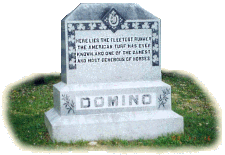
Photo © Elizabeth Martiniak
|
|
|
|

